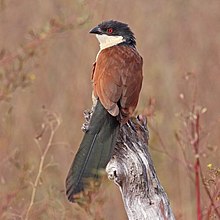Centropus senegalensis
| Senegal coucal | |
|---|---|
 |
|
| C. s. senegalensis, Gambia | |
| Scientific classification | |
| Kingdom: | Animalia |
| Phylum: | Chordata |
| Class: | Aves |
| Order: | Cuculiformes |
| Family: | Cuculidae |
| Genus: | Centropus |
| Species: | C. senegalensis |
| Binomial name | |
|
Centropus senegalensis (Linnaeus, 1766) |
|
The Senegal coucal (Centropus senegalensis) is a member of the cuckoo order of birds, the Cuculiformes, which also includes the roadrunners, the anis, and the hoatzin. It is a medium-sized member of its genus and is found in lightly-wooded country and savannah in central and southern Africa.
This is a medium-sized species at 39 cm (15 in). Its crown, nape and upper parts, bill, legs and long tail are black, the eyes are red, the wings are chestnut, and the underparts are creamy white, with blackish barring on the flanks. The sexes are similar, but juveniles are browner and more heavily barred above, with buff to cinnamon, barred and streaked underparts.
It is a widespread species distributed through much of central and southern Africa south of the Sahara Desert. The range extends from Senegal in the west to Ethiopia and Kenya in the east, and Angola and Congo to the south. A separate population in southern Africa is centred on Zambia, Zimbabwe and northern Botswana. The Senegal coucal is a bird of grassy habitats with trees, such as bushes and savannah.
The Senegal coucal takes a wide range of insects, caterpillars and small vertebrates. It occasionally eats other food items. It nests off the ground in low vegetation, and the typical clutch is two to four eggs laid in a large nest built from stalks and leaves.
This is an abundant species, which advertises its presence with a loud ook-ook-ook call. It has a very wide range and no particular threats have been identified so the International Union for Conservation of Nature has assessed its conservation status as being of "least concern".
...
Wikipedia

